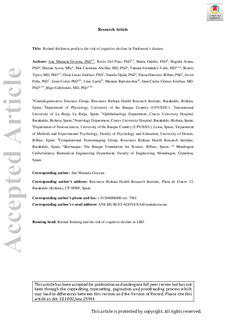
Izenburua
Retinal thickness predicts the risk of cognitive decline in Parkinson's diseaseEgilea (beste erakunde batekoa)
Argitalpen data
2021Beste erakundeak
BioCruces Health Research InstituteUniversidad del País Vasco/Euskal Herriko Unibertsitatea (UPV/EHU)
Universidad Internacional de La Rioja
Hospital Universitario de Cruces
Universidad de Deusto
Ikerbasque
Bertsioa
PostprintaDokumentu-mota
ArtikuluaArtikuluaHizkuntza
IngelesaEskubideak
© The AuthorsSarbidea
Sarbide irekiaArgitaratzailearen bertsioa
https://doi.org/10.1002/ana.25944Non argitaratua
Annals of Neurology First published: 24 October 2020Argitaratzailea
WileyGako-hitzak
neurodegenerationvisual dysfunction
optical coherence tomography
Laburpena
Objective: To analyze longitudinal changes of retinal thickness and their predictive value as biomarkers of disease progression in idiopathic Parkinson’s disease (iPD).
Methods: Patients with Lewy b ... [+]
Objective: To analyze longitudinal changes of retinal thickness and their predictive value as biomarkers of disease progression in idiopathic Parkinson’s disease (iPD).
Methods: Patients with Lewy body diseases (LBDs) were enrolled and prospectively evaluated at 3 years, including patients with iPD (n=42), dementia with Lewy bodies (DLB, n=4), E46K-SNCA mutation carriers (n=4) and controls (n=17). All participants underwent Spectralis retinal optical coherence tomography and Montreal Cognitive Assessment (MoCA), and Unified Parkinson’s Disease Rating Scale (UPDRS) score was obtained in patients. Macular ganglion-inner plexiform layer complex (GCIPL) and peripapillary retinal nerve fiber layer (pRNFL) thickness reduction rates were estimated with linear mixed models. Risk ratios were calculated to evaluate the association between baseline GCIPL and pRNFL thickness and the risk of subsequent cognitive and motor worsening, using clinically meaningful cut-offs.
Results: GCIPL thickness in the parafoveal region (1- to 3-mm ring) presented the largest reduction rate. The annualized atrophy rate was 0.63 µm in iPD patients and 0.23 µm in controls (p<0.0001). iPD patients with lower parafoveal GCIPL and pRNFL thickness at baseline presented an increased risk of cognitive decline at 3 years (RR 3.49, 95% CI 1.10 – 11.1, p=0.03 and RR 3.28, 95% CI 1.03 – 10.45, p=0.045, respectively). We did not identify significant associations between retinal thickness and motor deterioration.
Interpretation: Our results provide evidence of the potential use of OCT-measured parafoveal GCIPL thickness to monitor neurodegeneration and to predict the risk of cognitive worsening over time in iPD. [-]
Sponsorship
Michael J. Fox FoundationProjectu ID
RRIA 2014 (Rapid Response Innovation Awards) Program (Grant ID: 10189)Bildumak
Item honek honako baimen-fitxategi hauek dauzka asoziatuta:





















